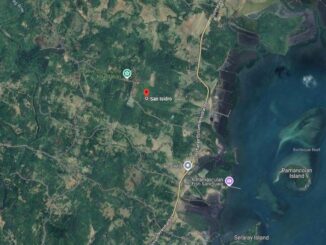
(UPDATES) AT least eight people died and two were injured as Typhoon Carina brought torrential rains across the country, the state disaster agency said Tuesday.
The National Disaster Risk Reduction and Management Council (NDRRMC) said seven of the eight fatalities have been validated, but the circumstances of their deaths were not reflected in its report.
Four of the dead were from Region 9, and one each was from Region 10, 11 and the Bangsamoro Autonomous Region in Muslim Mindanao (BARMM).
Carina affected 179,744 families or 866,483 persons, the hardest hit of which was BARMM, with 110,648 families or 553,241 persons, followed by Region 12 with 47,892 families or 233,322 persons, the NDRRMC reported.
Other areas affected by Carina were Regions 6, 7, 9, 10, 11, and Caraga.
The NDRRMC said 34 areas in Central Luzon were submerged in floods.
In the two days of rain, seven areas in Region 9 were rendered impassable to all types of vehicles due to flooded roads.
Some 236 houses were damaged.
Two areas in Region 12 and an area in Region 11 were placed under a state of calamity.
Signal No. 2 was raised over Batanes, particularly in the towns of Itbayat, Basco, Mahatao, Uyugan and Ivana, as Carina intensified while moving over the Philippine Sea, the state-run weather agency said on Tuesday.
In its 11 a.m. bulletin, the Philippine Atmospheric Geophysical and Astronomical Services Administration (Pagasa) said Signal No. 1 was up over the rest of Batanes (Sabtang), Cagayan, including the Babuyan Islands, the eastern portion of Isabela (Divilacan, Palanan, Maconacon, Dinapigue, Tumauini, Ilagan City, San Mariano, Cabagan, San Pablo and Santa Maria), the northern portion of Apayao (Calanasan, Luna, Pudtol, Flora and Santa Marcela), the northern portion of Ilocos Norte (Pagudpud, Bangui, Adams, Dumalneg, Burgos and Vintar), the northern portion of Aurora (Dilasag and Casiguran), Polillo Islands, Calaguas Islands, and the northern portion of Catanduanes (Pandan, Bagamanoc, Panganiban, Viga, Gigmoto and Caramoran) in Luzon.
Packing maximum sustained winds of 140 kilometers per hour (kph) near the center and gustiness of up to 170kph, the typhoon was moving westward at 15kph.
The center of the eye of Carina was estimated to be some 320 km east of Basco, Batanes or 405 km east-northeast of Aparri, Cagayan, Pagasa said.
The typhoon would remain far from the Philippine landmass.
Carina may make landfall, but it would be over the northern portion of Taiwan between Wednesday night and Thursday morning, then exit the Philippine Area of Responsibility.
Provincial disaster workers in Cagayan Valley were on alert for potential landslides as torrential rains pounded the eastern portion of the province.
Cagayan Provincial Disaster Risk Reduction Management Office (PDRRMC) officer Rueli Rapsing said they monitored soil erosion in some municipalities in the eastern portion of the province due to heavy rains.








Four low-lying bridges were flooded.
Flooded roads included the Tamucco-Balagan-Abariongan Ruar road in Sto. Niño and the farm-to-market road and bridge in Sitio Laoc, Gonzaga, Cagayan.
In Nueva Vizcaya, the national road in San Luis village in Diadi had only one lane passable due to soil erosion and mudslides.
As this developed, at least 96 people or 21 families fled to evacuation centers in Cagayan.
The Cagayan Provincial Disaster Risk Reduction and Management Office (PDRRMO) said as of 6 a.m. on July 23, 21 evacuated families were given food packs and other kits in Peñablanca, Gonzaga and Sta. Ana towns.
Five families or 20 people have been staying at the evacuation center or with their relatives in Barangay Camasi, Peñablanca.
In Gonzaga town, 13 families or 64 people have been staying at evacuation centers in Amunitan, Paradise, Progressive and Flourishing villages.
In Santa Ana, three families or 12 people were evacuated to the barangay hall in Kapanikian village.
In Batanes, fishermen have removed their boats along the coastline and relocated to higher and safer areas to avoid the impact of big waves.
In Ilocos Sur, fishermen have not ventured to sea for seven days due to rough seas and bad weather.
Kennon Road in Baguio City was shut down by a landslide.








City mayor Benjamin Magalong said in a memo that Kennon Road was closed effective Tuesday, July 23, to ensure the safety of motorists, pedestrians and residents.
Motorists were advised to take alternate routes at Marcos Highway and Baguio-Bauang Road.
The Asin-Nangalisan-San Pascual Road at Barangay Tadiangan, Tuba, Benguet, is also not passable because of falling rocks and fallen trees.
Carina's rains triggered flooding in the city of Batangas. Officials blamed small water outlets in flood control projects for the flooding.
In Manila, 25 families in Isla Puting Bato were forced to evacuate after big waves hit their houses, destroying some of them.
The evacuees were brought to a temporary shelter.
Four cities in northern Metro Manila canceled classes at all school levels for Tuesday due to the bad weather caused by Typhoon Carina and the southwest monsoon.
Caloocan Mayor Dale Gonzalo Malapitan told The Manila Times that the suspension of classes was based on the recommendation of the City Risk Reduction and Management Department (CRRMD).
In Malabon, City Administrator Alexander Rosete said Mayor Jeannie Sandoval ordered the suspension of classes at all levels in both public and private schools.
Navotas City Mayor John Rey Tiangco said the suspension of classes was also recommended by its risk reduction and management office as flood waters worsened by high tide would be likely given the heavy rain.
Classes at all levels from public and private schools in Valenzuela City were suspended following an announcement of a heavy rainfall warning from the state weather bureau.









Be the first to comment